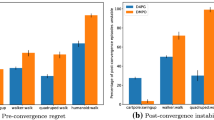Abstract
We present the main ideas of answer set planning in both single- and multi-agent environments. Specifically, we describe a systematic translation of a dynamic domain—given as set of statements in an action language such as \(\mathcal{B}\)—into a logic program which can be used for planning and other reasoning tasks (e.g., diagnosis) given the dynamic domain. We illustrate the issues of answer set planning in different settings and their solutions using a well-known problem domain, the Kiva robot system.




Similar content being viewed by others
Notes
This is a special case of the more general problem of finding a plan of any length. In this paper, we focus on the simpler variant to keep the presentation simple.
One may also use obs(f, i) and \(\lnot obs(f,i)\), but the representation we adopt simplifies the writing of some rules.
References
Balduccini M, Gelfond M (2003) Diagnostic reasoning with A-Prolog. J Theory Pract Log Program (TPLP) 3(4–5):425–461
Balduccini M, Gelfond M (2003) Logic programs with consistency-restoring rules. In: International symposium on logical formalization of commonsense reasoning, AAAI spring symposium series, pp 9–18
Balduccini M, Gelfond M, Watson R, Nogueira M (2001) The USA-advisor: a case study in answer set planning. In: Lectures notes in artificial intelligence (proceedings of the sixth international conference on logic programming and nonmonotonic reasoning, LPNMR’01), Springer, vol 2173, pp 439–442
Baral C, Son TC, Pontelli E (2010) Reasoning about multi-agent domains using action language \(\cal{C}\): a preliminary study. In: Dix J, Fisher M, Novák P (eds) Computational logic in multi-agent systems—10th international workshop, CLIMA X, Hamburg, Germany, September 9–10, 2009, Springer, vol 6214. Lecture notes in computer science, pp 46–63 (revised selected and invited papers)
Buccafurri F, Leone N, Rullo P (1997) Adding weak constraints to disjunctive datalog. In: Proceedings of the 1997 joint conference on declarative programming APPIA-GULP-PRODE’97, Grado, Italy
Durfee E (1999) Distributed problem solving and planning. In: Weiss G (ed) Muliagent systems (A modern approach to distributed artificial intelligence). MIT Press, Cambridge, pp 121–164
Gelfond M, Lifschitz V (1998) Action languages. Electron Trans. Artif Intell 3(6):195–210
Ghallab M, Howe A, Knoblock C, McDermott D, Ram A, Veloso M, Weld D, Wilkins D (1998) PDDL—the planning domain definition language. Version 1.2. Tech. Rep. CVC TR98003/DCS TR1165, Yale Center for Comp, Vis and Ctrl
Hayes PJ, McCarthy J (1960) Some philosophical problems from the standpoint of artificial intelligence. In: Meltzer B, Michie D (eds) Machine intelligence, vol 4. Edinburgh University Press, Edinburgh, pp 463–502
Kautz H, Selman B (1992) Planning as satisfiability. In: Proceedings of ECAI-92, Vienna, Austria, pp 359–363
Le HV, Pontelli E (2005) An investigation of sharing strategies for answer set solvers and SAT solvers. In: Cunha JC, Medeiros PD (eds) Euro-Par 2005, parallel processing, 11th international Euro-Par conference, Lisbon, Portugal, August 30–September 2, 2005, Springer. Proceedings, vol 3648. Lecture notes in computer science, pp 750–760
Lifschitz V (2002) Answer set programming and plan generation. Artif Intell 138(1–2):39–54
Marek V, Truszczyński M (1999) Stable models and an alternative logic programming paradigm. In: Apt K, Marek VW, Truszczynski M, Warren DS (eds) The logic programming paradigm: a 25-year perspective, Springer-Verlag, Berlin, Heidelberg, pp 375–398
Nguyen VD, Obermeier P, Son TC, Schaub T, Yeoh W (2017) Generalized target assignment and path finding using answer set programming. In: Proceedings of the Twenty-Sixth International Joint Conference on Artificial Intelligence (IJCAI 2017), Melbourne, Australia, pp 1216–1223
Niemelä I (1999) Logic programming with stable model semantics as a constraint programming paradigm. Ann Math Artif Intell 25(3, 4):241–273
Schneidenbach L, Schnor B, Gebser M, Kaminski R, Kaufmann B, Schaub T (2009) Experiences running a parallel answer set solver on blue gene. In: Ropo M, Westerholm J, Dongarra J (eds) Recent advances in parallel virtual machine and message passing interface, 16th European PVM/MPI users’ group meeting, Espoo, Finland, September 7–10, 2009, Springer, vol 5759, Proceedings, Lecture notes in computer science, pp 64–72
Son T, Pontelli E, Sakama C (2009) Logic programming for multiagent planning with negotiation. In: Hill PM, Warren DS (eds) Logic programming, 25th international conference, ICLP 2009, Pasadena, CA, USA, July 14–17, 2009, Springer. Proceedings, vol 5649. Lecture notes in computer science, pp 99–114
Son TC, Pontelli E, Nguyen N, Sakama C (2014) Formalizing negotiations using logic programming. ACM Trans Comput Log 15(2):12
Son TC, Pontelli E, Nguyen NH (2010) Planning for multiagent using ASP-Prolog. In: Dix J, Fisher M, Novák P (eds) Computational logic in multi-agent systems—10th international workshop, CLIMA X, Hamburg, Germany, September 9–10, 2009, Springer, vol 6214, Lecture notes in computer science, pp 1–21 (revised selected and invited papers)
Wurman P, D’Andrea R, Mountz M (2008) Coordinating hundreds of cooperative, autonomous vehicles in warehouses. AI Mag 29(1):9–20
Author information
Authors and Affiliations
Corresponding author
Rights and permissions
About this article
Cite this article
Son, T.C., Balduccini, M. Answer Set Planning in Single- and Multi-agent Environments. Künstl Intell 32, 133–141 (2018). https://doi.org/10.1007/s13218-018-0546-8
Received:
Accepted:
Published:
Issue Date:
DOI: https://doi.org/10.1007/s13218-018-0546-8




